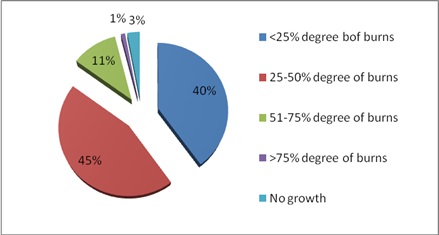Bacteriology of infected burn wounds in hospitals in and around Davangere
Abstract
Introduction: Study was conducted to isolate and identify the aerobic bacterial flora in burn wound patients admitted in and around hospitals of Davanagere. It also includes knowing common microbial pathogen involved in causing infection & antibiotic resistance pattern of isolates.
Methods: The study was done on 100 patients admitted to burns wards in the following 2 Hospitals in Davangere: Chigateri Government Hospital and Bapuji Hospital. Sample is collected from patients in 2 different swabs, one for smear and another for culture. Each pair of swabs from single patient is analysed for 3 days of thorough investigations like Day 1: Examining sample under Gram’s stain and inoculating for sample for culture. Day 2: Noting the morphological characteristics of growth and further for microscopy. Day 3: Final identification of organism and biochemical tests for gram negative organisms.
Result: According to the study results have been following in different categories like: Most common organisms found: Staphylococcus aureus and Pseudomonas aeruginosa. Staphylococcus aureus is most resistant to Penicillin G and 60% resistant to Methicillin whereas it is most sensitive to Chloramphenicol. It has various pattern of sensitivity for others various antibiotics.
Conclusion: As we get results from the study, it can concluded that staphylococcus aureus and Pseudomonas aeroginosa are the most common organisms causing infections in burn patients, and these organisms are becoming resistant to most of the present day antibiotics like Penicillin G and Methicillin, treating resistant strains is the challenging job now a days.
Downloads
References
2. Vindenes H, Bjerknes R. Microbial colonization of large wounds. Burns. 1995 Dec;21(8):575-9. [PubMed]
3. Pruitt BA Jr. Infection and the burn patient. Br J Surg. 1990 Oct;77(10):1081-2. [PubMed]
4. Bang RL, Gang RK, Sanyal SC, Mokaddas E, Ebrahim MK. Burn septicaemia: an analysis of 79 patients. Burns. 1998 Jun;24(4):354-61. [PubMed]
5. Revathi G, Puri J, Jain BK. Bacteriology of burns. Burns. 1998 Jun;24(4):347-9. [PubMed]
6. Davis B, Lilly HA, Lowbury EJ. Gram-negative bacilli in burns. J Clin Pathol. 1969 Nov;22(6):634-41. [PubMed]
7. Yemul VL and Senugupta SR: Bacteriology of burns. Burns 1981; 7: 190-193.
8. Sheridan RL, Ryan CM, Pasternack MS, Weber JM, Tompkins RG. Flavobacterial sepsis in massively burned pediatric patients. Clin Infect Dis. 1993 Aug;17(2):185-7. [PubMed]
9. Douglas MW, Mulholland K, Denyer V, Gottlieb T. Multi-drug resistant Pseudomonas aeruginosa outbreak in a burns unit--an infection control study. Burns. 2001 Mar;27(2):131-5.
10. Song W, Lee KM, Kang HJ, Shin DH, Kim DK. Microbiologic aspects of predominant bacteria isolated from the burn patients in Korea. Burns. 2001 Mar;27(2):136-9. [PubMed]
11. Zorgani A, Zaidi M, Franka R, Shahen A; The pattern and outcome of septicaemia in burns intensive care unit. Ann. Burns and Fire disasters 2002; 15: 179-182.
12. Pruitt BA Jr. The diagnosis and treatment of infection in the burn patient. Burns Incl Therm Inj. 1984 Dec;11(2):79-91. [PubMed]
13. Lesseva MI, Hadjiiski OG. Staphylococcal infections in the Sofia Burn Centre, Bulgaria. Burns. 1996 Jun;22(4):279-82. [PubMed]
14. Bang RL, Sharma PN, Bang S, Mokaddas EM, Ebrahim MK, Ghoneim IE. Septicaemia in scald and flame burns: appraisal of significant differences. Ann Burns Fire Disasters. 2007 Jun 30;20(2):62-8.
15. Sanyal SC, Mokaddas EM, Gang RX, Bang RL: Microbiology of septicaemia in burn patients. Ann Burns Fire Disasters 1998; 11: 19-22



 OAI - Open Archives Initiative
OAI - Open Archives Initiative


